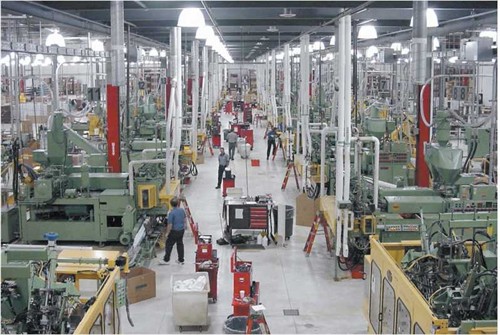Plastic Production
General Design and Application Considerations

Plastics manufacturers use blow molding or injection molding machines to provide various plastic parts, jars and bottles for OEM customers. These injection and blow molds are supplied with chilled water to cool the hot plastic as it fills or is expanded into the mold. If the humidity surrounding the mold is not controlled, fog and condensation will affect product flow rate and quality of the manufactured product.

By controlling the humidity surrounding the mold itself, there are many benefits that will be realized by the manufacturer. Some of these benefits are: faster production cycle times and product consistency year round, improved product appearance, lower maintenance costs and downtime of the mold surfaces and equipment, rust avoidance on the mold surfaces and improved mold labeling.
Environmental Standards or Requirements

In the process of injection and blow molding, plastic products are cooled by circulating chilled water through the mold press. When the mold press opens to release the product, the humidity in the air can condense onto the mold surface. In the past, the only way to combat the problem was to raise the water temperature of the coolant water above the surrounding air dewpoint. By doing so, the mold was not cool enough to condense the moisture from the air. By changing mold temperatures to meet weather conditions, plastic resin parameters change as well which can result in product inconsistency problems. Higher mold temperatures also increase cycle times which slow production.
By controlling the environment around the molding area, these problems can be significantly reduced or eliminated altogether. The most reliable way to achieve this control is to enclose the molding equipment itself and to inject dry air into the enclosure surrounding the molds with dry air. In facilities with high machine density in relation to overall square footage of the molding process area of the plant, it might be appropriate to dehumidify the entire process room.

Most often, the cooling water is simply chilled water rather that a chilled water/glycol mixture due to the water's higher refrigeration efficiencies. The water temperature generally is supplied at temperatures in the range of 45° to 48°F at the mold head. Therefore maintaining a dewpoint of less than the coldest possible mold surface temperature will prevent condensation on the mold's surface.
The exact supply air condition can be determined after assessing the typical temperature of the chilled water being used to cool the molds. The condition of the air surrounding the molding equipment, whether dehumidified by a whole plant system, or simply that designed to condition the individual enclosures, should be dry enough that the dewpoint of the air is kept below
the mold's surface temperature.
Reference Sources
- Manufacturers Association for Plastics Processors (MAPP), www.mappinc.com
- Society of Manufacturing Engineers (SME), www.sme.org
- Society of Plastics Engineers (SPE), www.4spe.org
- Process/Industrial Instruments and Controls Handbook, Rev. 5, G.K. McMillan, McGraw-Hill Publisher 1999.
Contact our Sales Engineers with your questions at sales@cdihvac.com or see our Contact Us page.
